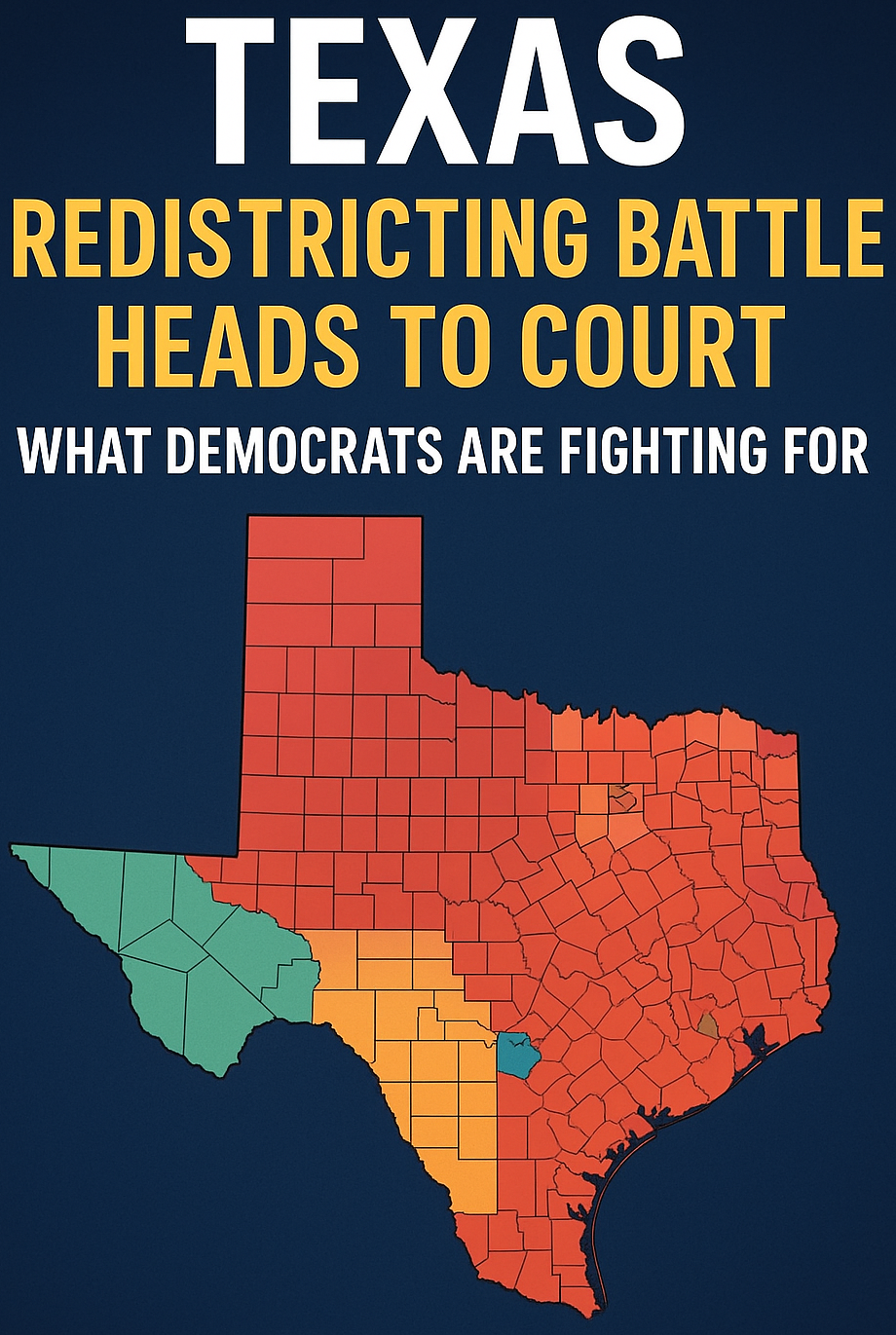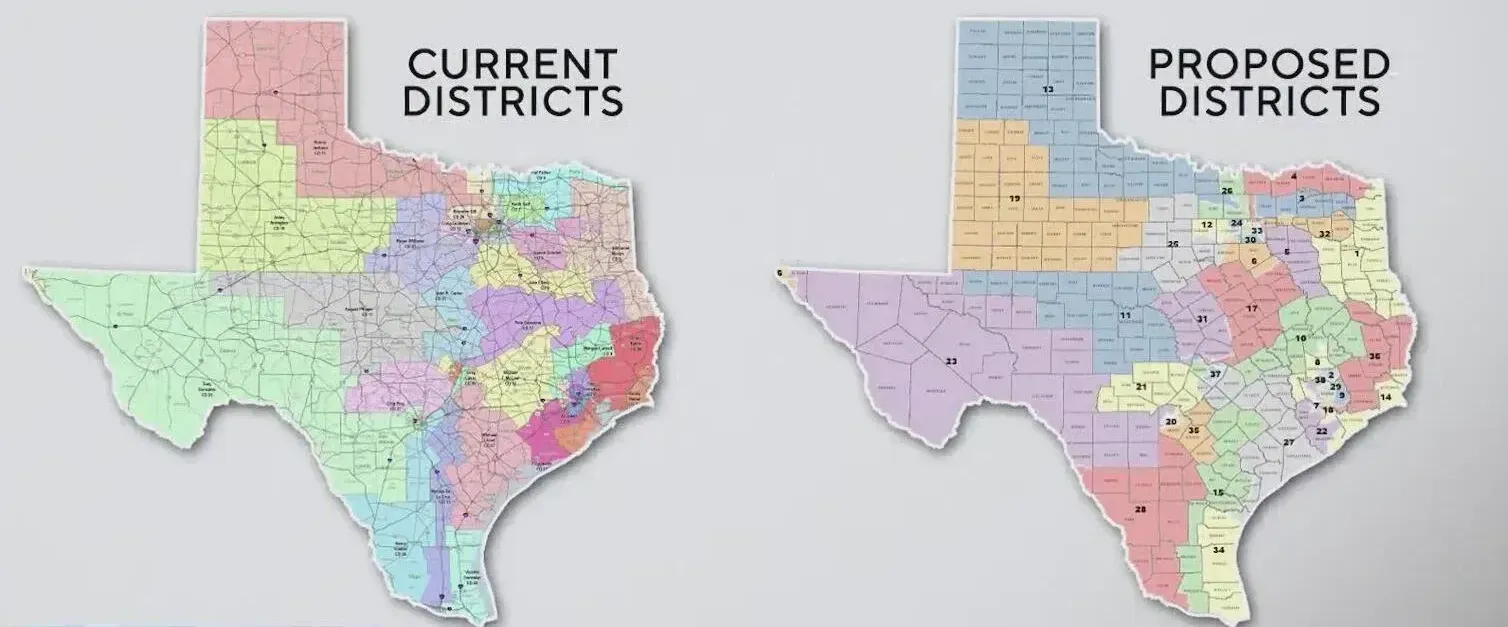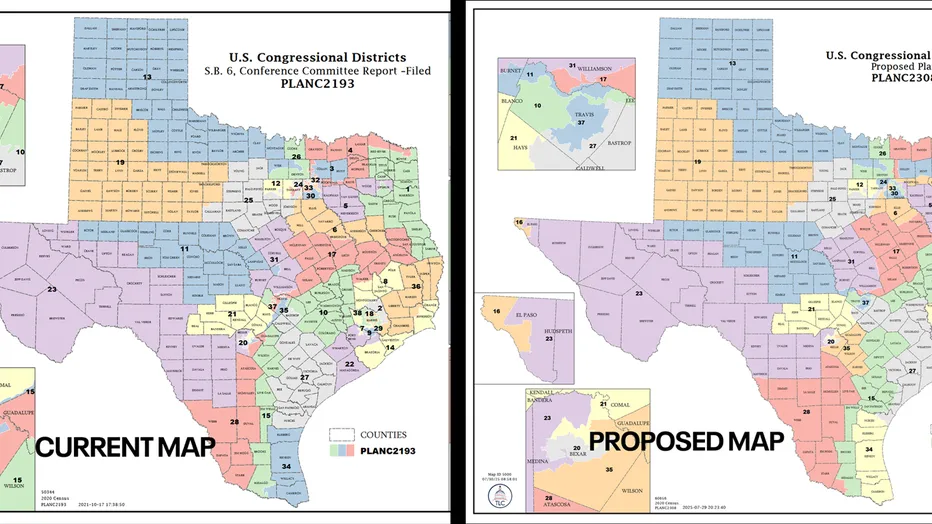The Legal Gauntlet: Texas Redistricting Battle Heads to Court, What Democrats Are Fighting For
Democrats and civil rights groups allege the maps are an illegal partisan and racial gerrymander, diluting the voting power of minority communities that drove 95% of the state's population growth.

Written by Lavanya, Intern, Allegedly The News
AUSTIN, TEXAS, August 21, 2025
The Texas State Capitol, a towering symbol of the Lone Star State's political independence, has become ground zero for the latest, and perhaps most consequential, battle over electoral maps in recent U.S. history. Following a dramatic two-week walkout by Democratic state lawmakers, the Republican-controlled legislature passed new congressional and state legislative maps. This move, openly pushed by President Donald Trump's political team, is designed to secure a significant electoral advantage for the GOP in the upcoming 2026 midterm elections and beyond.
But the fight is far from over. Democrats and a coalition of civil rights groups are preparing to mount a formidable legal challenge, alleging that these new maps are a blatant and illegal attempt at both partisan and racial gerrymandering. This battle is about more than just a few seats; it's a high-stakes test of the nation's commitment to fair representation and the future of voting rights in a country that is becoming more diverse every day.
The Anatomy of a Gerrymander: Packing and Cracking the Vote
The core of the Democratic legal challenge rests on the argument that the new maps intentionally dilute the voting power of minority communities. This is achieved through two classic gerrymandering tactics: "packing" and "cracking."
Packing: This strategy involves concentrating as many Democratic voters, and by extension, the minority voters who overwhelmingly support them, into a small number of "super-safe" districts. While this ensures that these districts will elect Democratic representatives, it siphons off Democratic votes from surrounding areas, making it easier for Republicans to win those adjacent districts. In practice, the new maps would reportedly pack Black and Hispanic voters into a handful of heavily Democratic districts in major metropolitan areas like Houston and Dallas. This effectively reduces the number of competitive districts where voters of color could influence the outcome.
Cracking: This tactic involves the opposite: splitting up a cohesive community of interest and spreading its voters across multiple districts. This ensures that the minority group's voting power is too small to influence the outcome in any single district. The new maps reportedly crack apart fast-growing minority communities in the Houston and Austin suburbs, dispersing their votes into sprawling, rural, and overwhelmingly white districts. For example, a Democratic-held district in Fort Worth represented by a Black member of Congress is reportedly being dismantled, with its minority voters split into three different districts.
This isn't just about party affiliation; it's about the very foundation of fair representation. The U.S. Census Bureau confirmed that 95% of Texas's population growth over the last decade came from communities of color. Yet, the new maps fail to create a single new congressional district where minority voters are a majority. This, plaintiffs will argue, is not a coincidence, but a deliberate effort to suppress the political power of a demographic that is rapidly changing the face of Texas.
A Historical Hotspot: Texas and the Legacy of Voter Suppression
Texas's current redistricting fight is not an isolated event but the latest chapter in a long and contentious history. For decades, Texas has been a laboratory for some of the most aggressive and legally contested electoral maps in the country. The state's redistricting plans have been challenged in court in every decade since the Voting Rights Act of 1965 was passed, and federal courts have repeatedly found that Texas acted with discriminatory intent against voters of color.
The Supreme Court's 2013 decision in Shelby County v. Holder, which gutted a key provision of the VRA, is a crucial piece of this history. That provision had required states with a history of voter discrimination, including Texas, to get federal approval for any changes to their voting laws. With that preclearance requirement gone, opponents say states like Texas have been emboldened to draw maps with a free hand. The 2021 maps, which were the subject of a federal trial, are a prime example of this newfound freedom, and the new mid-decade maps are seen as an even more aggressive step. The legal team for the plaintiffs in LULAC v. Abbott (2021), a case challenging the 2021 maps, is now poised to add the 2025 maps to their existing lawsuit.

A Bellwether for U.S. Democracy: The National Stakes
What's happening in Texas is a bellwether for the future of U.S. democracy. The GOP's success in redrawing these maps to pick up up to five new congressional seats has already triggered a national "tit-for-tat" response. Democratic leaders in states like California and New York are now considering their own mid-decade redistricting plans to counter the GOP's gains. This has the potential to spiral into a coast-to-coast redistricting war, where states draw and redraw maps in a never-ending quest for partisan advantage.
The outcome of the Texas legal challenge will have national implications for two main reasons. First, a court victory for Democrats would be a powerful precedent, proving that even without federal preclearance, states can be held accountable for racially discriminatory maps. This would provide a roadmap for future challenges in other states. Conversely, a Republican victory would legitimize mid-decade redistricting and signal that courts are unwilling to intervene on racial grounds when a partisan motive is also present. This would fundamentally weaken the remaining protections of the Voting Rights Act and the 14th Amendment.
This is a new era of political warfare, where the battle for control of Congress is fought not just at the ballot box but in the mapmaking rooms of state capitols and the hallowed halls of federal courthouses.
Expert Analysis: The Legal and Electoral Landscape
The legal challenges will focus on the 14th Amendment's Equal Protection Clause and Section 2 of the Voting Rights Act. Plaintiffs will need to prove that the maps were drawn with the intent to discriminate based on race. This can be difficult, as courts have allowed partisan gerrymandering to stand, and a key legal question is whether race and partisanship are so intertwined that a court must intervene.
"The Texas case is a perfect illustration of the modern gerrymander," said Michael Li, Senior Counsel for the Brennan Center for Justice's Democracy Program. "The mapmakers claim they're just drawing lines for partisan gain, which the Supreme Court has blessed. But when you have a state where voters of color are overwhelmingly Democratic, it's impossible to separate a partisan gerrymander from a racial one. The courts have to decide if that distinction is still meaningful."
The electoral consequences of the maps are profound. They would all but guarantee Republican control of Texas's congressional delegation for the rest of the decade, regardless of demographic trends. The new maps also reduce the number of competitive districts from 14 to just 4, a move that will likely lead to more extreme candidates and less responsive representation.
The GOP's strategy is not without risks. An overly aggressive gerrymander could backfire, leading to unexpected electoral risks. By creating a few "super-safe" Democratic districts, the party could lose its ability to turn out moderate voters in other areas. The backlash from the Democratic walkout and the new maps has already energized activists and fueled unprecedented grassroots organizing. This could lead to a massive turnout among the very communities the maps are designed to suppress, creating a potential "boomerang effect" that puts the GOP's seemingly impregnable advantage at risk.

A Tipping Point for American Politics
The Texas redistricting fight is a pivotal moment in American politics. It brings into sharp focus the tension between a state's right to manage its own elections and the fundamental promise of equal representation. For Texans, and especially for the state's burgeoning communities of color, the outcome of this legal battle will determine whether their growing numbers translate into political power or are simply a statistical footnote. The fate of the 2026 midterms, and potentially the balance of power in Washington for the next decade, may very well be decided not by voters, but by a handful of federal judges in a Texas courtroom.
Call to Action: What You Can Do
Stay Informed, Stay Engaged: Follow the legal challenges in the Texas courts and at the federal level. Your knowledge is your most powerful tool. The fight for fair maps is a long one, but it's not a lost cause. Support the Fighters: Organizations like the League of United Latin American Citizens (LULAC), the NAACP, and the Brennan Center for Justice are leading the legal charge. Your support for their work, whether through donations or volunteering, is critical to ensuring a fair outcome.
Sources
The Texas Tribune, The New York Times, The Brennan Center for Justice, The Associated Press.




